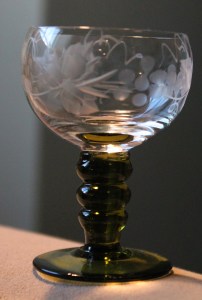 These little stems aren’t my usual choice. But they are sturdy and attractive. They’re not uncommon and can be seen frequently with and without the etch. They also have amber stems with slightly different patterns.
These little stems aren’t my usual choice. But they are sturdy and attractive. They’re not uncommon and can be seen frequently with and without the etch. They also have amber stems with slightly different patterns.
No idea who actually made them. Similar glasses are frequently advertised as Roemer Glass. But I don’t think this is the name of the manufacturer.
This is an interesting explanation of Roemer Glass from Deutsches Haus:
“The History of Roemer Wine Glasses
The knowledge of how to make glass began in the Middle East around 4500 B.C. Glass first started out in the form of beads and then around 1700 B.C. it took on the shape of a hollow container.
During this time, the Roman Empire had set up glass works in Italy, France and the Rheinland. By the 2nd century, glass works had spread to Spain, Belgium, the Netherlands, Switzerland and Britain. At this time, the wine glass was in the shape of a hollow vessel with no stem, but had large melted beads of glass that protruded from the outisde glass area which made it easier to hold on to.
By the 4th century, and with the collapse of the Roman Empire, glass shapes began to take on a more regional identity and because of the sand in different areas, the color of the glass would sometimes be different. “Forest Glass” which was made from forest potash and a sand that contained iron impurities was being produced in France. This is where the green color started and for many years, the entire wine glass was green.
The word “Römer” was derived from the Latin word “Roma, for Rome and dedicated to the romans who initially brought the first grape vines into Germany. It also refers to the custom of using this style of glass to toast the Holy Roman Emperor. Today, in Germany, the Roemer is regarded as a traditional toasting glass.
Over the years, wine glasses started to look more sophisticated. Engraving was added to the bowls for the decorations and sometimes gold was added to the rims. Wine connoisseurs started recommending that wine should be served in a clear wine glass, and eventually, just the stems were kept green. It was also thought that the green stems would reflect the color of the pale wines of the regions into the clear bowls.
France had a large influence in the design of these wine glasses, particularly from the province of Alsace which is just across the Rhine from Germany. Alsatians produced two traditional white wines – rieslings and gewürtztraminers. These wines were and continue to be bottled in green bottles and served in special glasses with clear bowls and green stems. In many countries, a wide bowl on a wine glass is usually thought more suited for red wines, however, the Alsatians thought it was the best way to bring out the floral scent of the white wines.
Today, roemer wine glasses are still considered a traditional toasting glass and most popular in Germany. They are still used to serve white wines and seen all over Germany.”
So…it would appear that my little glasses were intended to be toasting glasses, made in Germany and likely not too old.
Here is a blog with some interesting photos and some further information – Ancient Glass Blog of the Allaire Collection.
